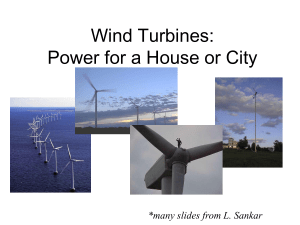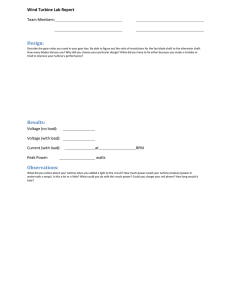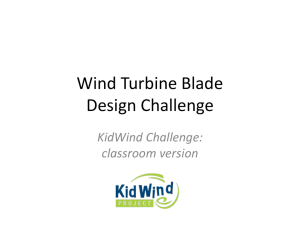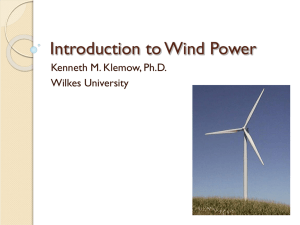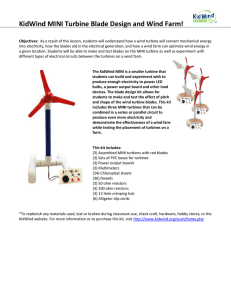show wind map - Delaware Sea Grant
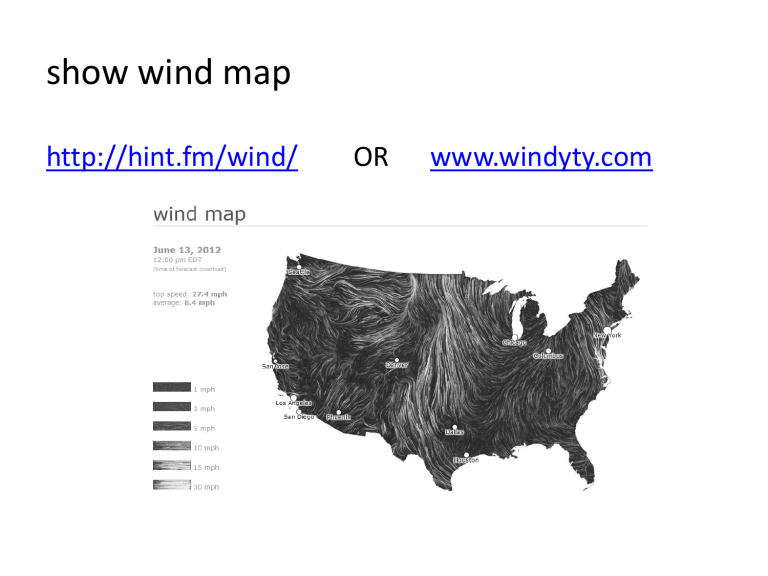
show wind map http://hint.fm/wind/ OR www.windyty.com
Wind Energy and the
University of Delaware’s
Lewes Turbine
Chris Petrone
Delaware Sea Grant / UD CEOE petrone@udel.edu
@seaPetrone
How do we use our electricity?
• iPod
–
5-7 watts (when charging)
–
1 watt (when plugged in and not charging)
•
Laptop
–
45 watts
•
Xbox 360
–
160 watts
•
DVD player
–
35 watts
How do we use our electricity?
•
Hair dryer
–
1300 watts
•
Refrigerator
–
200-700 watts (compressor is active)
–
60-160 watts (average)
•
Electric oven at 350˚
–
2000 watts
•
Electric clothes dryer
–
4400 watts
How do we use our electricity?
Household Electricity
Consumption (U.S.)
Copyright © (data) US Department of Energy's Energy Information Agency
How do we use our electricity?
•
How much would it cost to run this
100 Watt bulb for a full day (24 hrs)?
•
100 Watts x 24 hours = 2400 Watt Hours
(2400 Watt Hours = 2.4 Kilowatt Hours)
•
2.4 kWh x $0.08/kWh =
$0.19
•
What about this 25 Watt CFL light bulb, which produces the same amount of light?
•
25 Watts x 24 hours = 600 Watt Hours
(600 Watt Hours = 0.6 Kilowatt Hours)
•
0.6 kWh x $0.08/kWh =
$0.05
Where do we get our electricity?
biomass
1.32%
U.S. Electricity Fuel Mix, 2014 petroleum
0.77% solar
0.44% wind
4.51% hydro
6.35% nuclear
21.69% natural gas
21.80% coal
42.71%
Credit: Dan Kasper; data from Lawrence Livermore National Laboratory geothermal
0.41%
Where do we get our energy?
U.S. Energy Fuel Mix, 2014 solar
0.44% wind
1.76% hydro
2.52% nuclear
8.49% geothermal
0.21% petroleum
35.46% natural gas
28.02% biomass
4.87% coal
18.24%
Credit: Dan Kasper; data from Lawrence Livermore National Laboratory
Where do we get our energy and electricity?
45.00%
40.00%
35.00%
30.00%
25.00%
20.00%
15.00%
10.00%
5.00%
0.00% electricity use (%) energy use (%)
Credit: Dan Kasper; data from Lawrence Livermore National Laboratory
What is “Renewable Energy?”
KidWindProject.org
Wind Turbine History
•
Concept is more than 2000 years old
•
Persia (Iran) 900
AD
•
Early electric turbines in
Denmark—
1880’s
Image Credit: Wind Power Explained
Early “Windmill” in Afghanistan (900AD)
Orientation
Turbines can be categorized into two overarching classes based on the orientation of the rotor
Vertical Axis Horizontal Axis
Vertical Axis Turbines
Advantages
•
Omnidirectional
–
Accepts wind from any angle
•
Components can be mounted at ground level
–
Ease of service
–
Lighter weight towers
•
Can theoretically use less materials to capture the same amount of wind
Disadvantages
•
Rotors generally near ground where wind poorer
•
Centrifugal force stresses blades
•
Poor self-starting capabilities
•
Requires support at top of turbine rotor
•
Requires entire rotor to be removed to replace bearings
•
Overall poor performance and reliability
•
Have never been commercially successful
(large scale)
Vertical Axis
Modern Darrieus Turbine
Horizontal Axis Wind
Turbines
•
Rotors are usually Up-wind of tower
•
Some machines have down-wind rotors, but only commercially available ones are small turbines
•
Proven, viable technology
Horizontal Axis
Danish Gedser Turbine—1957
Types of Electricity Generating Windmills
Small ( ≤ 10 kW)
• Homes
• Farms
• Remote Applications
(e.g. water pumping, telecom sites, icemaking)
Intermediate
(10-250 kW)
• Village Power
• Hybrid Systems
• Distributed Power
Large (250 kW - 2+MW)
• Central Station Wind Farms
• Distributed Power
KidWind Project | www.kidwind.org
Parts of a Wind Turbine
Parts of the Nacelle
Diagram of Wind Turbine
Yaw
Controller
Image Credit: Vestas
Blade Pitch
Controller
Gear Demonstration http://illuminations.nctm.org/ActivityDetail.aspx?ID=178
LOW-SPEED
SHAFT
GEAR BOX
HIGH-SPEED
SHAFT
GENERATOR
Gamesa G90 gear ratio is ~1:110
KidWind Project | www.kidwind.org
Chain of Power
KidWindProject.org
So how does this thing work?
•
Newton’s Third Law
–
To every action there is always an equal and opposite reaction (the forces of two bodies on each other are always equal and are directed in opposite directions)
Airfoil Shape
Just like the wings of an airplane, wind turbine blades use the airfoil shape to create lift and maximize efficiency.
Bernoulli’s principle
KidWindProject.org
Why do windmills need to be high in the sky??
Turbulent wind is bad wind
Feasibility Study:
Meteorological Tower
Construction
May, 2008
X
Construction
Construction
Credit: Lisa Tossey
Construction
Credit: Lisa Tossey
Construction
Credit: Lisa Tossey
Construction
Credit: Lisa Tossey
Construction
Credit: Lisa Tossey
Construction
Credit: Lisa Tossey
Construction
Construction
Credit: Lisa Tossey
Construction
Construction
Credit: Lisa Tossey
Construction
Credit: Lisa Tossey
Construction
Credit: Lisa Tossey
Construction
Construction
Assembled in ~ 3 days
(crane = $10K/day)
Credit: Lisa Tossey
Completed
Credit: Lisa Tossey
Gamesa G-90 2MW
•
Tower height 256 feet
•
Tower weight 203 tons
•
Nacelle weight 103 tons
•
Number of blades 3
•
Blade length 144 feet
•
Total blade weight
Approximately 7 tons
•
Blade material Fiberglass and carbon fiber
•
Rotational speed 9–19 revolutions per minute
404’
Gamesa G-90 2MW
305’
256’
Gamesa G-90 2MW
Full school bus is about 19 tons, so nacelle weighs the same as full school buses!
… and one blade weighs the same as full school buses!
Credit: Ron MacArthur Credit: Ron MacArthur
Construction www.ceoe.udel.edu/LewesTurbine/multimedia.shtml
Turbine Production Overview
(June 11, 2010–May 31, 2011)
•
Gross Turbine Production: 5,143,200 kWh
•
Energy sent to turbine:
•
Net turbine production:
34,800 kWh
5,108,400 kWh
•
Lewes (city) wind energy consumption:
•
Enough electricity for about 105 Lewes homes
1,283,880 kWh
Capacity factor: .3 (30%) typical for wind is 20-40%; 30% is almost perfect for a 250’ turbine in Del.
UD Turbine’s first year
June 2010–May 2011
Predicted annual production – 5.25-5.5 million kWh
Average annual UD-Lewes net usage – about 5 million kWh
From http://www.ceoe.udel.edu/lewesturbine/documents/turbine1yrsum-62311.pdf
Daily variation, April 2011
From http://www.ceoe.udel.edu/lewesturbine/documents/turbine1yrsum-62311.pdf
*Miles per hour
Gamesa G90-2.0 MW
Power Curve
2000
1750
1500
1250
1000
750
500
250
0
0 2 4 6 8 10 12 14 16 18 20 22 24 26 28 30 32 34 36 38 40 42 44 46
Wind speed (mph)
Recreated from www.iberdrolarenewables.us/roaringbrook/DEIS_Appendices/Appendix-A-Component-Specs-and-Construction-Info/2-Gamesa_Eolica_G90.pdf
*Meters per second
Gamesa G90-2.0 MW
Power Curve
2000
1750
1500
1250
1000
750
500
250
0
0 1 2 3 4 5 6 7 8 9 10 11 12 13 14 15 16 17 18 19 20
Wind speed (m/s)
Recreated from www.iberdrolarenewables.us/roaringbrook/DEIS_Appendices/Appendix-A-Component-Specs-and-Construction-Info/2-Gamesa_Eolica_G90.pdf
Jobs in the Wind Industry
•
Engineering/Design
•
Construction
•
Operations
•
Maintenance
•
Public Relations
•
Environmental
Impact/Assessment
•
Research
•
Policy/Law
•
Permitting
UD student projects
Altitude vs. Wind Speed
115,000
90,000
75,000
60,000
45,000
30,000
15,000
0
0 10 20 30 40 50 60
Wind Speed (miles per hour)
70 80 90 100
Source: National Weather Service
Wind energy in the future
From Altaeros Energy
From Magenn From Kitegen
Electricity!
More efficient light bulbs are great, but what is the BEST way to conserve electricity and reduce our consumption of fossil fuels?
*Turn it off ■ *Unplug it ■ *Drive less
Be conscious of your energy choices!
http://environment.nationalgeographic.com/environment/global-warming/wind-power-interactive/
>>> “Try It Out”
•
Curriculum
•
Kits
•
Competitions
•
Teacher PD kidwind.org
www.ceoe.udel.edu/LewesTurbine/
Calculation of Wind Power
• Power in the wind
3
– Effect of swept area, A
– Effect of wind speed, V
– Effect of air density, ρ
R
Swept Area: A = πR 2 Area of the circle swept by the rotor (m 2 ).
KidWind Project | www.kidwind.org
Impacts of Wind Power:
Noise
•
Modern turbines are relatively quiet
•
Rule of thumb – stay about 3x hub-height away from houses
Elementary
•
Engineering is Elementary
•
Wind Chimes
•
Wind Art
•
Building simple blades
streamers balloon
~3m
Middle
Kite or balloon string
•
Building Wind
Turbines
•
Assessing Wind
Resource
•
Mathematics
Secondary
•
Advanced Blade Design
•
School Siting Projects
•
Data Analysis
•
Advanced Math
